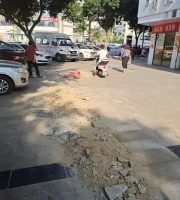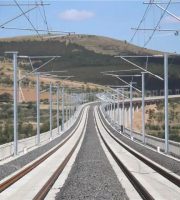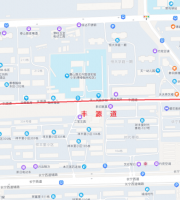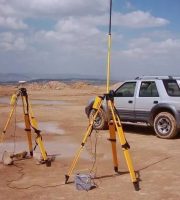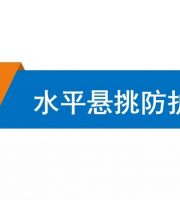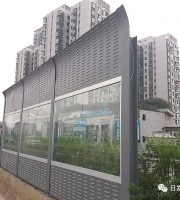③ The material shall be cut in strict accordance with the design requirements and the requirements of 16g101-1 leveling method to ensure that the anchorage of reinforcement at all places meets the requirements.
The vertical bars of the wall are evenly distributed, the horizontal bars are bound horizontally and evenly spaced, and the spacing of tie bars is less than 600, which meets the requirements.
The wall column reinforcement joints shall be staggered for at least 500mm and not less than 35d.
The position of the protruding reinforcement of the lower wall and column deviates too much from the design requirements and cannot be overlapped with the reinforcement of the upper wall and column.
Qualification criteria: as shown in the figure below, the anchorage mode and length of reinforcement meet the requirements of design and leveling method.
The beam reinforcement anchored into the column does not cross the column center line 5D.
⑥ The anchorage of horizontal reinforcement at the wall corner does not meet the requirements.
③ The length of wall and column reinforcement extending into the foundation bearing platform or out of the floor and roof is not enough.
Click to pay attention: more engineering skills are shared from the summary of the most complete common reinforcement quality problems in the whole network of Fujian Supervision Association! Quality standards for anchorage of reinforcement in the catalogue and common quality problems in prevention and control: ① the anchorage length of beam reinforcement extending into the wall and column is insufficient or the anchorage method is improper, and the blanking is not carried out according to the design requirements if there are seismic requirements.
After the column head concrete construction is completed, the reinforcement is completely reset and meets the requirements.
④ The anchorage length of the horizontal reinforcement of the shear wall at both ends, corners, cross joints, coupling beams and other parts, as well as the reinforcement around the opening, all meet the design seismic requirements.
The length of the top of the wall column reinforcement extending out of the wall and the top anchorage method meet the requirements.
Qualification criteria: as shown in the following figure ① the position of main stressed reinforcement of wall and column is accurate, and the positioning and binding are firm.
The secondary beam reinforcement is misplaced under the main beam reinforcement, the additional stirrups on both sides of the node are not as required, and the stirrups are not normally distributed in the main beam in the node area.
It is not allowed to simply set a seven hook reinforcement and bind it at the root.
③ The stirrup shall be made as required and bound firmly with the longitudinal reinforcement of the column.
④ The anchorage of cantilever beam reinforcement or cantilever plate reinforcement does not meet the design requirements or specification requirements.
② The wall column joint reinforcement of the foundation part shall be short reinforcement insertion, connected layer by layer, and fixed by spot welding with positioning stirrup to ensure that the joint reinforcement skeleton is not deformed.
⑤ If the length of wall and column reinforcement extending out of the floor is not enough, it shall be pre inserted in time before concrete pouring to ensure the length of the upper end.
The column longitudinal reinforcement shall be positioned reliably, bound firmly and vertically.
⑦ Improper treatment of offset reinforcement.
Preventive measures: ① check the stressed reinforcement before reinforcement binding to avoid blanking error or installation error.
④ The position of main and secondary beam reinforcement is incorrect.
The anchorage length of cantilever beam reinforcement is not enough, and the reinforcement skeleton is inclined.
The negative reinforcement of the beam support is disconnected at the node and is bound and overlapped, which does not meet the requirements.
The beam reinforcement spacing at the beam column joint does not meet the requirements, and the reinforcement position does not meet the requirements.
The anchorage length of the secondary beam into the main beam meets the requirements.
The vertical reinforcement of the wall shall be evenly distributed, and the binding level and spacing of the horizontal reinforcement shall be uniform, meeting the requirements.
The anchorage length of the secondary beam into the main beam meets the requirements.
The anti-seismic anchorage length of 18mm grade III reinforcement is not enough, and it shall be 42d in C25 concrete.
The two bars in the middle of the beam are close together, and the clear distance does not meet the requirements.
The vertical reinforcement and horizontal reinforcement of the shear wall are evenly distributed, the position is accurate, the tie reinforcement is in place and the installation is reasonable.
The length of horizontal reinforcement of shear wall is not enough and does not reach the edge of end column.
The main stress-bearing reinforcement of the beam is offset and not installed in place, which does not meet the requirements, and the effective stress-bearing section of the beam becomes smaller.
③ The negative reinforcement of beam support is disconnected at the node, and the full-length reinforcement is not used, but installed in the way of binding and overlapping.
③ During the installation of beam and slab reinforcement, the main beam reinforcement shall be placed first, and the secondary beam reinforcement shall be placed on the main beam reinforcement after the main beam reinforcement framework is bound.
If the rebar is wrong, the column should be all grade III steel of 22, and one of them is wrong to use rebar of 20.
The anchor length of the ground beam into the bearing platform is too short to meet the requirements.
The top structure of the vertical reinforcement of the shear wall does not meet the requirements, and the anchorage length and anchorage method do not meet the requirements.
⑤ If the wall column reinforcement has been offset, it shall be planted with reinforcement.
⑤ The anchorage length of plate bottom reinforcement or surface reinforcement into the beam is not enough to meet the design or specification requirements.
When the protruding reinforcement of the lower layer is less than that of the upper layer, the overlapping position shall be in the lower layer.
Stable roof support measures such as hooping and temporary support can also be taken.
③ The length of horizontal reinforcement of shear wall is not enough.
Prevention measures: ① make technical disclosure.
At the intersection of main and secondary beams, the secondary beam reinforcement is placed under the main beam reinforcement, and the installation position does not meet the requirements.
③ Tie bars or support bars shall be bound between two rows of reinforcement of shear wall, and the vertical and horizontal spacing shall not be greater than 600mm.
The anchorage length of the top column reinforcement is insufficient, and the beam reinforcement is not anchored into the joint.
Quality standard for installation of main stressed reinforcement of beam and common quality problems: ① the spacing of beam bottom and surface reinforcement does not meet the minimum clear distance requirements, or the spacing of reinforcement is different and chaotic, and the spacing of two or more rows of reinforcement does not meet the requirements (falling into the beam or the upper and lower rows are too tight).
④ The spacing of wall and column reinforcement is uneven, too large or too small, and the binding is not vertical.
The beam reinforcement is not installed in place and the deviation is serious.
The stagger of adjacent joints of wall column reinforcement is only 460mm, which does not meet the requirements of 35d and 500mm.
The wall pre joint reinforcement is skewed and one end deviates from the axis.
② The anchorage length of secondary beam reinforcement into the main beam does not meet the requirements.
② The size, grade, shape, size, quantity, anchorage length, joint position and blanking length of reinforcement meet the design requirements.
The length of the shear wall reinforcement extending out of the floor is insufficient, the top anti beam reinforcement is wrongly anchored, and it is not anchored into the wall column.
② Review the reinforcement blanking sheet of the team.
⑦ The concealed acceptance of reinforcement shall be done well before concrete pouring to ensure the installation quality of reinforcement.
The anchorage length of the ground beam into the bearing platform is not enough.
② The pre inserted reinforcement of the foundation is skewed or out of position.
⑧ The vertical stressed reinforcement of wall column and adjacent reinforcement joints are not staggered as required or the staggered distance does not meet the requirements.
The distance between the two rows of reinforcement at the beam bottom and the bottom reinforcement is too large.
④ When binding two or more rows of stressed reinforcement of the beam, short reinforcement head or tie bar measures shall be used to separate and bind firmly.
The deviation of shear wall reinforcement is serious, the treatment method does not meet the requirements, and the distance from the first horizontal reinforcement to the root is too large.
The anchorage length of beam reinforcement into the wall is not enough, and the bending end is not up to 15d.
Quality standards for installation of main stressed reinforcement of walls and columns and common quality problems in prevention and control: ① the measures for fixing reinforcement are unreliable, or it is bumped and tilted by vibrator or other things during concrete pouring, and it is not reset and corrected in time.
⑥ When the column intersects with the beam and wall, the principle of column reinforcement wrapping the beam and wall reinforcement shall be followed.
② The beam reinforcement framework is not straight, the main stress reinforcement of the beam is not in place, and the effective stress section is reduced.
If it is not long enough, it shall be removed and redone in time.
The spacing of stressed reinforcement in shear wall is disordered, the size is different, and the deviation along the wall length is large.
The reinforcement of the shear wall extending out of the floor shall be evenly distributed, the length shall meet the requirements, effectively positioned, and the adjacent reinforcement shall be staggered from each other.
The anchorage length of the beam into the wall meets the requirements, and the bending section also reaches 15d.
The column reinforcement shall be firmly positioned, accurately positioned and evenly spaced.
Prevention and control measures: ① mark the dimension line of the cross-section frame of the wall and column on each floor according to the design requirements, and then use two stirrups or positioning horizontal bars to spot weld and fix the longitudinal bars at 500mm above the floor elevation of this floor with each longitudinal bar to ensure the position of each longitudinal stress bar.
⑤ The size of the main stressed reinforcement is wrong, or the reinforcement is missing.
When the wall column concrete is poured, the stressed reinforcement is not reset in time, resulting in the deviation of reinforcement.
④ The length of the horizontal reinforcement of the shear wall must be cut in strict accordance with the drawing requirements.
② At the beam column or beam wall joint, the position of reinforcement shall be reasonably adjusted to avoid the collision between beam reinforcement and wall column reinforcement, resulting in the reinforcement not being in place correctly.
The anchorage length and mode of horizontal reinforcement at the wall corner do not meet the requirements.
The distance between the upper and lower rows of reinforcement in the beam shall be within 75mm, and the net distance shall not be less than 25mm or the maximum diameter of reinforcement..
⑥ When the section size of wall and column changes, the main reinforcement is improperly bent and does not meet the requirements.
The reinforcement is simply placed with hook reinforcement, and the treatment does not meet the requirements.
The adjacent joints of wall column reinforcement shall be staggered with each other, and the length shall meet the requirements.
The end column reinforcement of shear wall is seriously offset and has not been properly treated.
④ If the anchorage length is not enough, it shall be re cut or welded for extension, or the position of reinforcement shall be adjusted appropriately.
